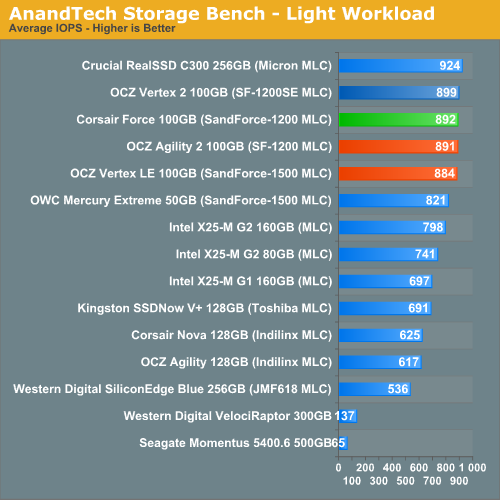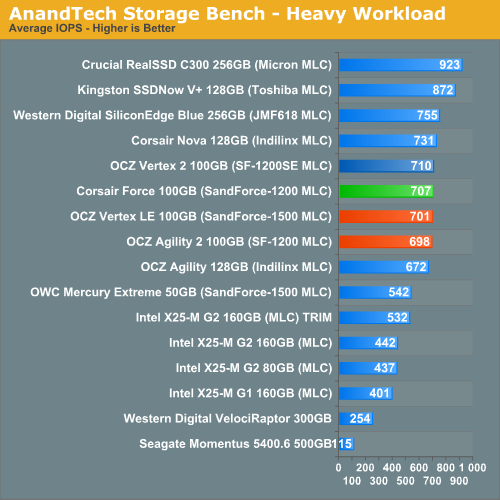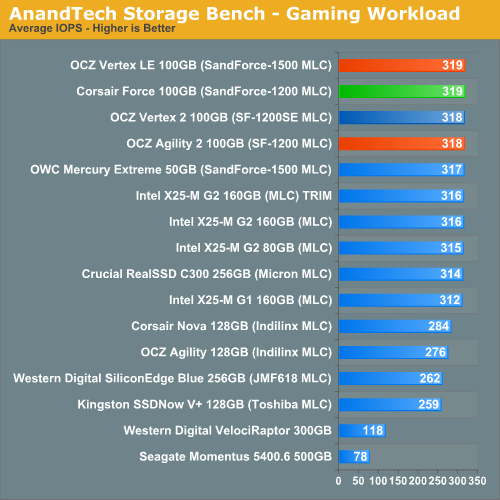OCZ's Vertex 2, Special Sauce SF-1200 Reviewed
by Anand Lal Shimpi on April 28, 2010 3:17 PM ESTAnandTech Storage Bench
Note that our 6Gbps controller driver isn't supported by our custom storage bench here, so the C300 results are only offered in 3Gbps mode.
The first in our benchmark suite is a light usage case. The Windows 7 system is loaded with Firefox, Office 2007 and Adobe Reader among other applications. With Firefox we browse web pages like Facebook, AnandTech, Digg and other sites. Outlook is also running and we use it to check emails, create and send a message with a PDF attachment. Adobe Reader is used to view some PDFs. Excel 2007 is used to create a spreadsheet, graphs and save the document. The same goes for Word 2007. We open and step through a presentation in PowerPoint 2007 received as an email attachment before saving it to the desktop. Finally we watch a bit of a Firefly episode in Windows Media Player 11.
There’s some level of multitasking going on here but it’s not unreasonable by any means. Generally the application tasks proceed linearly, with the exception of things like web browsing which may happen in between one of the other tasks.
The recording is played back on all of our drives here today. Remember that we’re isolating disk performance, all we’re doing is playing back every single disk access that happened in that ~5 minute period of usage. The light workload is composed of 37,501 reads and 20,268 writes. Over 30% of the IOs are 4KB, 11% are 16KB, 22% are 32KB and approximately 13% are 64KB in size. Less than 30% of the operations are absolutely sequential in nature. Average queue depth is 6.09 IOs.
The performance results are reported in average I/O Operations per Second (IOPS):

If there’s a light usage case there’s bound to be a heavy one. In this test we have Microsoft Security Essentials running in the background with real time virus scanning enabled. We also perform a quick scan in the middle of the test. Firefox, Outlook, Excel, Word and Powerpoint are all used the same as they were in the light test. We add Photoshop CS4 to the mix, opening a bunch of 12MP images, editing them, then saving them as highly compressed JPGs for web publishing. Windows 7’s picture viewer is used to view a bunch of pictures on the hard drive. We use 7-zip to create and extract .7z archives. Downloading is also prominently featured in our heavy test; we download large files from the Internet during portions of the benchmark, as well as use uTorrent to grab a couple of torrents. Some of the applications in use are installed during the benchmark, Windows updates are also installed. Towards the end of the test we launch World of Warcraft, play for a few minutes, then delete the folder. This test also takes into account all of the disk accesses that happen while the OS is booting.
The benchmark is 22 minutes long and it consists of 128,895 read operations and 72,411 write operations. Roughly 44% of all IOs were sequential. Approximately 30% of all accesses were 4KB in size, 12% were 16KB in size, 14% were 32KB and 20% were 64KB. Average queue depth was 3.59.

The gaming workload is made up of 75,206 read operations and only 4,592 write operations. Only 20% of the accesses are 4KB in size, nearly 40% are 64KB and 20% are 32KB. A whopping 69% of the IOs are sequential, meaning this is predominantly a sequential read benchmark. The average queue depth is 7.76 IOs.











44 Comments
View All Comments
carleeto - Thursday, April 29, 2010 - link
I don't think people are going to use an SSD for music and movies any time soon. At least, not until the price per GB falls within 200% of a normal hard drive. Where I could see this kind of thing being used a lot on an SSD is with a Truecrypt partition that is used to store source code, documents, mail etc. That's a lot of small writes and reads and the result, because of the encryption layer is really quite random. So I'd actually disagree with Anand here - it is something that is going to be quite relevant to a security conscious user and that is quite a large market, when you factor in enterprises.NandFlashGuy - Wednesday, April 28, 2010 - link
At my workplace, all PCs have PGP software installed. That should make the data in all writes to disk look like random data, meaning less than optimal performance.Anand, can you measure performance under the normal benchmarks with PGP installed? It's a realistic use case for anyone in the corporate world.
Squuiid - Wednesday, April 28, 2010 - link
Anand, any news on how your replacement Crucial RealSSD C300 is holding up? Did Crucial fix the performance deterioration bug you last talked about?Can you recommend the Crucial over the Vertex 2, or vice versa?
Grit - Wednesday, April 28, 2010 - link
I'd like to second that request. The Crucial drive manages impressive speeds in most benchmarks and does so without the loss in space. I can live with a 256GB SSD, but a 200GB SSD is cutting it a bit too close.DesktopMan - Wednesday, April 28, 2010 - link
Will there be any tests on the AES features? Since this is a feature not present in most SSDs an article on how it works and performs would be very interesting.vol7ron - Wednesday, April 28, 2010 - link
All these comments, so little time :)Looks good.
diamondsw - Wednesday, April 28, 2010 - link
As much ink has been spilled about SandForce, I still haven't seen anything that would indicate it's a better choice than the Crucial RealSSD C300, which has better performance at a (slightly) better price. Am I missing something important?arehaas - Wednesday, April 28, 2010 - link
Crucial C300 have a problem with its firmware that Crucial hasn't solved yet. Performance degrades significantly. Anand found this problem in a "Crucial's RealSSD C300: An Update on My Drive" from March 25. Crucial is currently promising to release the new firmware in mid-May, but they have shifted this deadline already twice. There is no guarantee they will manage to do it in May. Major reviewers do not recommend buying C300 SSD yet.xiphmont - Wednesday, April 28, 2010 - link
I expect Crucial will fix their firmware issue just as it appears that Sandforce has fixed theirs.The Sandforce's redundancy (silent correction and reprovisioning around bit errors and failed flash cells) is what sells me on the Sandforce. If the promises are true, these drives will last longer and throw unrecoverable errors far less often as the NAND ages. Performance is a nice extra.
It terrifies me that the other mass production SSDs appear to offer no redundancy or error detection/correction of stored bits at all.
jimhsu - Thursday, April 29, 2010 - link
Sandforce attempts to scare you with this in their marketing literature. ALL SSDs (even crappy first gen JMicron ones) do a substantial amount of error correction (the raw error rate for flash is something ridiculously bad like 10^-7 to 10^-8). I think even camera flash memory has embedded error correction (don't take my word for it though). Sandforce just does "more" than its competitors.